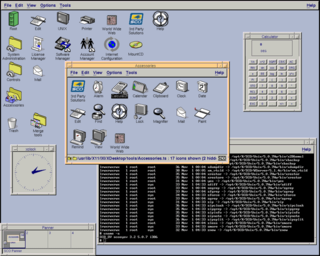Related Research Articles
AppleTalk is a discontinued proprietary suite of networking protocols developed by Apple Computer for their Macintosh computers. AppleTalk includes a number of features that allow local area networks to be connected with no prior setup or the need for a centralized router or server of any sort. Connected AppleTalk-equipped systems automatically assign addresses, update the distributed namespace, and configure any required inter-networking routing.
Internet Small Computer Systems Interface or iSCSI is an Internet Protocol-based storage networking standard for linking data storage facilities. iSCSI provides block-level access to storage devices by carrying SCSI commands over a TCP/IP network. iSCSI facilitates data transfers over intranets and to manage storage over long distances. It can be used to transmit data over local area networks (LANs), wide area networks (WANs), or the Internet and can enable location-independent data storage and retrieval.

InfiniBand (IB) is a computer networking communications standard used in high-performance computing that features very high throughput and very low latency. It is used for data interconnect both among and within computers. InfiniBand is also used as either a direct or switched interconnect between servers and storage systems, as well as an interconnect between storage systems. It is designed to be scalable and uses a switched fabric network topology. By 2014, it was the most commonly used interconnect in the TOP500 list of supercomputers, until about 2016.
Tandem Computers, Inc. was the dominant manufacturer of fault-tolerant computer systems for ATM networks, banks, stock exchanges, telephone switching centers, 911 systems, and other similar commercial transaction processing applications requiring maximum uptime and zero data loss. The company was founded by Jimmy Treybig in 1974 in Cupertino, California. It remained independent until 1997, when it became a server division within Compaq. It is now a server division within Hewlett Packard Enterprise, following Hewlett-Packard's acquisition of Compaq and the split of Hewlett-Packard into HP Inc. and Hewlett Packard Enterprise.

Quadrics was a supercomputer company formed in 1996 as a joint venture between Alenia Spazio and the technical team from Meiko Scientific. They produced hardware and software for clustering commodity computer systems into massively parallel systems. Their highpoint was in June 2003 when six out of the ten fastest supercomputers in the world were based on Quadrics' interconnect. They officially closed on June 29, 2009.

NetWare is a discontinued computer network operating system developed by Novell, Inc. It initially used cooperative multitasking to run various services on a personal computer, using the IPX network protocol.

Caldera International, Inc., earlier Caldera Systems, was an American software company that existed from 1998 to 2002 and developed and sold Linux- and Unix-based operating system products.

Network-attached storage (NAS) is a file-level computer data storage server connected to a computer network providing data access to a heterogeneous group of clients. The term "NAS" can refer to both the technology and systems involved, or a specialized device built for such functionality.

The Santa Cruz Operation, Inc. was an American software company, based in Santa Cruz, California, that was best known for selling three Unix operating system variants for Intel x86 processors: Xenix, SCO UNIX, and UnixWare.

UnixWare is a Unix operating system. It was originally released by Univel, a jointly owned venture of AT&T's Unix System Laboratories (USL) and Novell. It was then taken over by Novell. Via Santa Cruz Operation (SCO), it went on to Caldera Systems, Caldera International, and The SCO Group before it was sold to UnXis. UnixWare is typically deployed as a server rather than a desktop. Binary distributions of UnixWare are available for x86 architecture computers. UnixWare is primarily marketed as a server operating system.
OpenSSI is an open-source single-system image clustering system. It allows a collection of computers to be treated as one large system, allowing applications running on any one machine access to the resources of all the machines in the cluster.
Helios is a discontinued Unix-like operating system for parallel computers. It was developed and published by Perihelion Software. Its primary architecture is the Inmos Transputer. Helios' microkernel implements a distributed namespace and messaging protocol, through which services are accessed. A POSIX compatibility library enables the use of Unix application software, and the system provides most of the usual Unix utilities.

Xinuos OpenServer, previously SCO UNIX and SCO Open Desktop, is a closed source computer operating system developed by Santa Cruz Operation (SCO), later acquired by SCO Group, and now owned by Xinuos. Early versions of OpenServer were based on UNIX System V, while the later OpenServer 10 is based on FreeBSD 10.
Network Systems Corporation (NSC) was an early manufacturer of high-performance computer networking products. Founded in 1974, NSC produced hardware products that connected IBM and Control Data Corporation (CDC) mainframe computers to peripherals at remote locations. NSC also developed and commercialized the HYPERchannel networking system and protocol standards, adopted by Cray Research, Tektronix and others. In the late 1980s, NSC extended HYPERchannel to support the TCP/IP networking protocol and released a product allowing HYPERchannel devices to connect to the emerging Internet.

On Linux, network block device (NBD) is a network protocol that can be used to forward a block device from one machine to a second machine. As an example, a local machine can access a hard disk drive that is attached to another computer.
LOCUS is a discontinued distributed operating system developed at UCLA during the 1980s. It was notable for providing an early implementation of the single-system image idea, where a cluster of machines appeared to be one larger machine.
Locus Computing Corporation was formed in 1982 by Gerald J. Popek, Charles S. Kline and Gregory I. Thiel to commercialize the technologies developed for the LOCUS distributed operating system at UCLA. Locus was notable for commercializing single-system image software and producing the Merge package which allowed the use of DOS and Windows 3.1 software on Unix systems.

A storage area network (SAN) or storage network is a computer network which provides access to consolidated, block-level data storage. SANs are primarily used to access data storage devices, such as disk arrays and tape libraries from servers so that the devices appear to the operating system as direct-attached storage. A SAN typically is a dedicated network of storage devices not accessible through the local area network (LAN).
A VMScluster, originally known as a VAXcluster, is a computer cluster involving a group of computers running the OpenVMS operating system. Whereas tightly coupled multiprocessor systems run a single copy of the operating system, a VMScluster is loosely coupled: each machine runs its own copy of OpenVMS, but the disk storage, lock manager, and security domain are all cluster-wide, providing a single system image abstraction. Machines can join or leave a VMScluster without affecting the rest of the cluster. For enhanced availability, VMSclusters support the use of dual-ported disks connected to two machines or storage controllers simultaneously.
ONTAP or Data ONTAP or Clustered Data ONTAP (cDOT) or Data ONTAP 7-Mode is NetApp's proprietary operating system used in storage disk arrays such as NetApp FAS and AFF, ONTAP Select, and Cloud Volumes ONTAP. With the release of version 9.0, NetApp decided to simplify the Data ONTAP name and removed the word "Data" from it, and remove the 7-Mode image, therefore, ONTAP 9 is the successor of Clustered Data ONTAP 8.
References
- ↑ Walker, Bruce J.; Steel, Douglas (1999), "Implementing a Full Single System Image UnixWare Cluster: Middleware vs Underware", in Arabnia, Hamid R. (ed.), International conference on parallel and distributed processing techniques and applications, vol. 6, Las Vegas, Nevada, USA: CSREA Press, pp. 2767–2773, ISBN 1-892512-15-7, OCLC 48259379 , retrieved 2013-10-18
- ↑ Compaq Integrity XC server launched, 1998-08-11, retrieved 2008-10-07
- ↑ Orlowski, Andrew (2000-06-26), "SCO, Compaq ServerNet-less clusters", The Register , retrieved 2008-10-28
- ↑ Orlowski, Andrew (2000-08-23), "More on SCO's Linux-in-UnixWare gambit", The Register , retrieved 2008-10-28
- ↑ Orlowski, Andrew (2001-11-14), "Compaq cavalry rescues Linux clusters", The Register , retrieved 2008-10-28